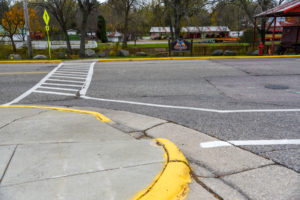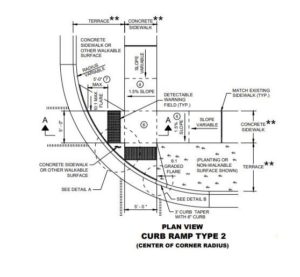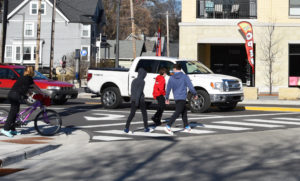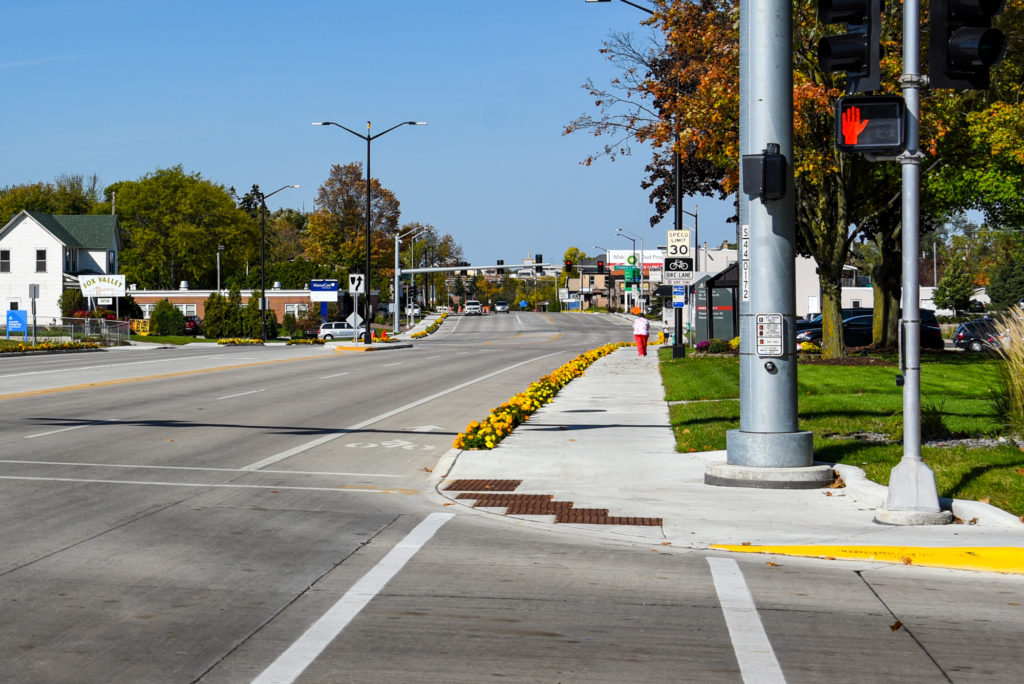While most municipalities include curb ramps, not all of them today meet the regulations in the Americans with Disabilities Act (ADA). Learn about these standards below, and see how raSmith can help ensure your curb ramps are compliant.
A brief background
Since 1990, the ADA states that state and local governments are required to ensure that people with disabilities have access to the pedestrian routes in the public right-of-way. That’s why sidewalk crossings at curbed intersections or driveways need curb ramps to provide accessibility. These regulations are overseen by the U.S. Department of Justice (USDOJ) and enforced by the U.S. Department of Transportation (USDOT).
ADA requirements for curb ramps
Among the many reasons why a curb ramp may not follow ADA requirements, here are the most common reasons:
- There are improper or no detectable warning fields to guide disabled pedestrians.
- Curb ramp cross slopes are steeper than the 2% maximum.
- Curb ramps’ running (longitudinal) slopes are steeper than the maximum allowable slopes.
- Curb ramps exceed the maximum change in grade (slope) between the gutter pan and the curb ramp.
- There’s inadequate space for and/or an improper slope on the landing at the top of the curb ramp.
To ensure ADA compliant curb ramps, there are two sets of ADA standards that are recognized and should be followed:
Additionally, the Wisconsin Department of Transportation’s (WisDOT) Facilities Development Manual (FDM) is a great resource when evaluating and designing curb ramps for compliance in Wisconsin. Based on the ADA standards, the FDM offers detailed drawings and other insightful guidance for designing and constructing compliant curb ramps.
Does your project require a new curb ramp?
Projects on streets or roadways, which are classified as an “alteration” per the USDOJ and USDOT joint technical assistance memo, need to include the installation or reconstruction of curb ramps.
According to this memo, an alteration is defined as:
a change that affects or could affect the usability of all or part of a building or facility. Alterations of streets, roads, or highways include activities such as reconstruction, rehabilitation, resurfacing, widening and projects of similar scale and effect.
On the other hand, “maintenance” activities on streets or highways are not considered alterations, so these types of projects don’t need curb ramp installation/reconstruction. Some examples of maintenance activities include filling potholes, painting or striping lanes, crack filling and surface sealing.
What are municipalities with non-compliant curb ramps required to do?
According to the federal government, public entities with 50 or more employees (large cities or counties) must develop self-evaluation and transition plans to improve non-compliant curb ramps. These public entities need to identify (self-evaluate) non-compliant, or non-existent, curb ramps and develop a transition plan to address these locations. The transition plan normally prioritizes curb ramp improvements, designates a responsible person within the public entity for implementing the improvement plan, and outlines funding mechanisms to complete the needed improvements.
Most small municipalities take the following systematic approach to improve their curb ramps to be ADA compliant:
- When new roadways or sidewalks are built as part of a development, their zoning laws and development agreements require curb ramps to be constructed to ADA standards.
- When existing roadways are reconstructed, reconditioned or resurfaced, non-compliant curb ramps are updated.
- Some municipalities set aside special funding to complete “spot” curb ramp improvements based on specific requests from individuals or to concentrate and accelerate improvements in high pedestrian traffic areas.
We can help
raSmith’s engineers have assisted our clients in evaluating non-compliant curb ramps and developing reasonable, cost-effective solutions for improving them. Having designed numerous urban roadway reconstruction projects, we understand how to ensure curb ramps meet the ADA requirements while minimizing adjacent impacts (buildings, parking lots, etc.) and limiting the need for acquisition of additional real estate interests. For example, our design of Oneida Street’s reconstruction in Appleton, Wisconsin included 78 new curb ramps with many special features and modifications to fit this tight urban environment.
Additionally, raSmith is working with WisDOT’s Southwest Region to evaluate and design over 300 curb ramps along state highways in the communities of Reedsburg, Baraboo, Rock Springs, and Beloit to be ADA compliant. raSmith is also working on updating the curb ramp design portion of the WisDOT FDM.
Let our experts help you identify and evaluate non-compliant curb ramps in your community and develop a systematic plan to design compliant improvements.
Learn more about raSmith’s traffic and transportation engineering services, or contact our team today.




